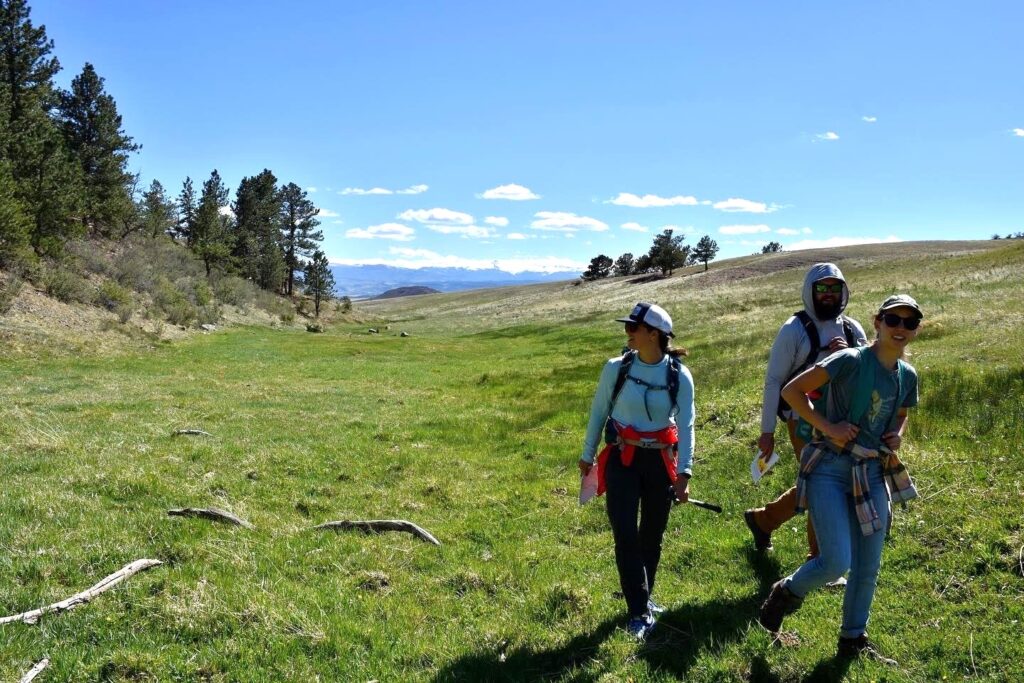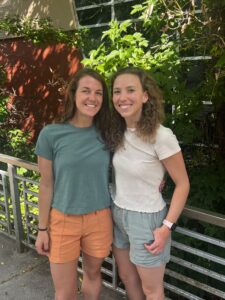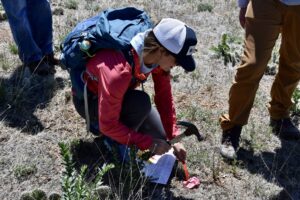
Colorado State University civil engineering graduate students are conducting a U.S. Army study that helps predict how heavy vehicles safely traverse unfamiliar terrain. The study could have wide-ranging applications for ranchers, park rangers and many others.
Graduate students Sami Fischer and Holly Proulx are spearheading an effort to enhance coarse satellite data to create fine-resolution soil moisture maps, producing a more accurate and specific set of data to inform decisions on vehicle mobility. They are advised by civil and environmental engineering professors Jeff Niemann and Joe Scalia.
The impact of soil moisture

Soil moisture can drastically impact the ability of vehicles to traverse a landscape, even one that appears on the surface to be relatively flat and stable. The amount of moisture in the soil can change from one footstep to the next and from day to day, yet current satellite data provide only a single measurement for nine-kilometer grid cells. While the coarse data are sufficient for weather models, more accuracy is needed for broader applications.
To create the higher resolution soil moisture maps, Fischer and Proulx use satellite data known as “SMAP” (Soil Moisture Active Passive) along with high-resolution data of the topography and vegetation. The research team then measures soil samples in the field to compare their moisture against models.
Satellites, probes, and rovers
The students measure soil moisture using two methods: HydraProbes and a cosmic ray neutron rover.
HydraProbes are handheld devices that are inserted into the ground and measure soil moisture at that location. The cosmic ray neutron rover is an emerging technology that can be driven over an area, collecting soil moisture data for the surrounding ~290-meter diameter region. Cosmic rays are subatomic particles originating from outside of our solar system which move at the speed of light. When cosmic rays interact with water, they slow down, providing a method for moisture detection and measurement that almost sounds like science-fiction.
Fischer focuses on the accuracy in their data. “The idea is for the model to be applicable at any site. We need to quantify the accuracy of the inputs and results so the end user can make informed decisions on the terrain and moisture present in the soil,” said Fischer.
In addition to the hillsides, valleys, and various terrains studied in the project, Proulx is examining unimproved roads, or trails.
“Every current soil moisture downscaling model is applied to landscape locations with native soils and vegetation where external compaction is not occurring,” said Proulx.
Water, like humans, prefers the path of least resistance. In the trails and beaten paths where humans, animals, and vehicles may most often travel, the soil will compact and the vegetation will diminish, making it more difficult for water to move through or stay in the soil.
Broadening the application
The project is funded by the U.S. Army’s DEVCOM Analysis Center and the Leonard Wood Institute to improve the Army’s ability to predictably traverse unfamiliar terrain with heavy vehicles and military machinery.
The research could have a much broader application.
“This model could be applied to agriculture, disaster response, and other fields in which traveling across an unknown landscape effectively can have a great impact,” said Proulx.
With her research on soil moisture patterns on unimproved roads, Proulx also has hopes for future collaboration with the U.S. Forest Service and U.S. National Park Service. “In the snowy and rainy seasons, the hiking trails in the foothills will close upon a ranger’s discretion, but with a model like this they may be able to open and close more automatically according to moisture conditions and trafficability.”
“Knowledge of soil moisture is fundamental to predicting how soil will behave,” said Scalia, an expert in soil behavior. “The difference between a firm trail and a mud bog can be just a few percentage points of soil moisture.”
The gift of land

To ensure the accuracy of their model across any topography, Fischer and Proulx needed a diverse landscape for sampling areas with various vegetation and physical characteristics. They conducted their research on nearly 12,000 acres of land at Maxwell Ranch owned by CSU.
“Last summer, we collected samples from the ranch at 86 different locations over 10 dates in very diverse landscapes. We now have over 750 data points for comparison with our satellite data to give us a better idea of how well our model is predicting soil moisture and strength, so we can modify and improve it,” said Fischer.
The ranch was a gift to CSU from the late Fred and Maude Maxwell in the 1970’s who wanted the land to be used for research, especially to advance the cattle industry.
“Understanding soil moisture patterns across landscapes can help ranchers better manage grazing lands. It can help them avoid overgrazing in vulnerable areas, which can lead to the spread of invasive weeds and damage to the soil,” said Niemann, an expert in surface hydrology.
About Maxwell Ranch
The mission of the ranch is to provide CSU, industry, and society with an economically sustainable working cattle ranch as a living laboratory for teaching, research, and demonstration with special emphasis on beef cattle production and rangeland research.
Joel Vaad has served as the Maxwell Ranch manager since 2004, overseeing day-to-day operations and living at the ranch with his family. Vaad takes pride in maintaining the ranch as if were his own and not just a job.
“My priority is to operate the ranch in a self-sustainable way, so the cows pay all of the bills,” said Vaad. Without external funding supporting the ranch, self-sustainability is a necessity.
Vaad first worked at the ranch as an intern from the animal sciences program at CSU in 1994, then became foreman in 1997.
“We just love ranch life. We love working with the animals in this beautiful setting where no day is the same.”